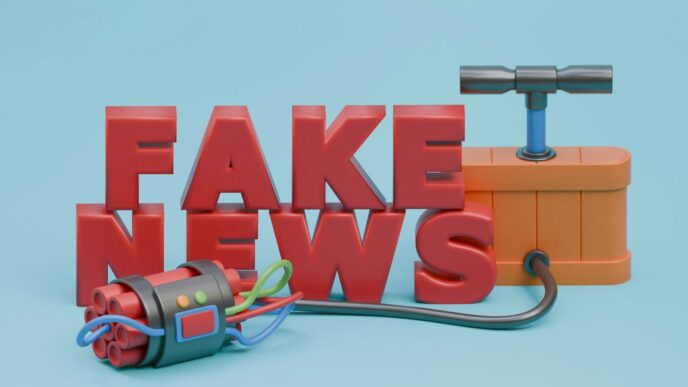Remember when newspapers used to scream their headlines at you? That loud, bold style of reporting, often more about grabbing your attention than telling the whole truth, is what we call yellow journalism. It’s a bit like the wild west of news, where sensational stories and dramatic flair were king. We’re going to look at some classic yellow journalism today examples and see how that old playbook still shows up in our news feeds, even with all our fancy technology.
Key Takeaways
- Yellow journalism from the past used big headlines and dramatic stories to sell papers, often stretching the truth.
- Today, we see similar tactics in tabloid news and online clickbait, where getting clicks is often more important than being accurate.
- The “fake news” problem online shares roots with yellow journalism, using emotions and biases to spread information.
- Historical examples, like the Spanish-American War coverage, show how sensational news can really shape what people think and even lead to big events.
- Understanding yellow journalism today examples helps us be smarter about the news we consume and question what we’re being told.
The Enduring Echoes Of Yellow Journalism Today Examples
It’s wild how much of what we see in the news today feels like a throwback to the old days of "yellow journalism." Remember when newspapers were all about screaming headlines and wild stories? Well, that spirit is definitely still alive, just in new packaging.
Sensationalism And Exaggeration In Modern News
This is probably the most obvious connection. Think about how some news outlets today really lean into the dramatic. They’ll take a regular event and blow it way out of proportion, using loaded language and focusing on the most shocking angles. It’s less about informing you and more about making you feel something intense – fear, anger, outrage. The goal is often to grab your attention first and worry about the full picture later. It’s like they’re selling a feeling, not just facts.
The Power Of Bold Headlines In The Digital Age
Back in the day, those giant, colorful headlines were designed to catch your eye on a crowded newsstand. Today, it’s the same idea, but online. We’re bombarded with information, so a headline has to be punchy, intriguing, and sometimes, downright misleading, to get you to click. It’s a constant battle for eyeballs. You see it everywhere, from news sites to social media feeds. These headlines often promise a lot, but the actual story might be a letdown, or worse, inaccurate.
Visual Storytelling’s Double-Edged Sword
Newspapers back then used illustrations and photos to make their stories pop. Today, we have video, infographics, and all sorts of fancy graphics. They can make complex stories easier to understand and more engaging. But just like with headlines, visuals can also be used to manipulate. A carefully chosen photo or a dramatic video clip can evoke a strong emotional response, sometimes without showing the full context. It’s a powerful tool, but it needs to be used responsibly, which, let’s be honest, doesn’t always happen.
Tabloid Journalism And Its Yellow Roots
You know, when you look at today’s tabloids, it’s hard not to see the ghosts of newspapers past. The whole tabloid scene, with its focus on celebrity drama and juicy scandals, really owes a lot to the original "yellow journalism" era. Think back to the late 1800s – newspapers were locked in this crazy circulation war, and they figured out that if they made things loud and exciting, people would buy more. It wasn’t always about the facts; it was about grabbing your attention, no matter what.
Celebrity Gossip And Scandalous Headlines
This is where tabloids really shine, or maybe "shriek" is a better word. They live for the personal lives of famous people. You’ll see headlines that are practically screaming about affairs, divorces, or some minor celebrity’s latest meltdown. It’s all designed to make you stop and stare, even if the story itself is pretty thin. They’ve gotten really good at making a tiny bit of gossip sound like the biggest news of the century. It’s a tactic that worked back then with crime and political scandals, and it definitely works now with movie stars and reality TV personalities.
Questionable Tactics For Exclusive Stories
Getting that "exclusive" story often means crossing lines. Back in the day, yellow journalists might have paid off sources or even outright made things up. Today’s tabloids might use paparazzi who are a little too aggressive, or they might buy information from people who aren’t exactly reliable. It’s a constant push to get something nobody else has, and sometimes, the truth gets bent, or even broken, in the process. It’s a tricky game, trying to get the scoop without completely losing your credibility, though many seem to manage just fine.
Maintaining Readership Despite Criticism
Here’s the funny thing: people complain about tabloids. They say they’re trashy, inaccurate, and just plain silly. Yet, they keep selling. Why? Because they tap into something basic – curiosity. We like to know what other people are up to, especially if they seem to have perfect lives. Tabloids offer a peek behind the curtain, even if that peek is heavily edited or completely fabricated. It’s a cycle: sensational headlines get clicks and sales, which funds more sensational stories, and the criticism just becomes part of the noise. It’s a business model that, for better or worse, has proven remarkably resilient.
Clickbait: The Digital Descendant Of Sensationalism
Remember when headlines used to just, you know, tell you what the story was about? Those days feel like a distant memory online. Now, we’ve got clickbait, and it’s basically the internet’s version of yellow journalism. It’s all about grabbing your attention, making you curious, and getting that click, no matter what.
Misleading Headlines For Online Engagement
These headlines are crafted to make you stop scrolling. They often use vague language, ask questions they don’t immediately answer, or hint at something shocking without giving away the details. Think phrases like "You Won’t Believe What Happened Next!" or "This One Weird Trick Will Change Your Life." The goal is pure engagement, not necessarily informing you. It’s a tactic that plays on our natural curiosity, pushing us to click just to find out the answer.
Prioritizing Attention Over Accuracy
This is where clickbait really shows its yellow journalism roots. The focus shifts from reporting facts to generating clicks. Sometimes, the content behind the headline doesn’t even match the promise, or it’s incredibly shallow. It’s like ordering a fancy meal and getting a single, unseasoned cracker. The article might be technically about the topic, but it’s stretched thin, filled with fluff, or just plain misleading to keep you on the page longer.
The Role Of Social Media In Amplifying Reach
Social media platforms are the perfect breeding ground for clickbait. Algorithms often favor content that gets a lot of engagement, and clickbait headlines are designed to do just that. When a clickbait article gets shared, it spreads like wildfire, reaching more people who might fall for the same trick. This creates a cycle where sensational, attention-grabbing headlines are rewarded, pushing more of them into our feeds and making it harder to find reliable information.
The ‘Fake News’ Phenomenon And Its Parallels
It feels like everywhere you look these days, someone’s talking about ‘fake news.’ It’s a term that gets thrown around a lot, and honestly, it can be pretty confusing. But if you think about it, this whole ‘fake news’ thing has some serious roots in the old days of yellow journalism. Remember how sensational headlines and exaggerated stories were used to grab attention? Well, it’s kind of the same game, just played on a much bigger stage now.
Exploiting Biases And Emotions Online
Back in the day, newspapers would play on people’s fears and prejudices to sell more papers. Today, it’s happening online, but with even more precision. Algorithms can figure out exactly what makes you tick, what buttons to push. It’s not just about making things up; it’s about knowing what kind of made-up stuff you’re most likely to believe and share. This can lead to some pretty wild echo chambers where people only see information that confirms what they already think, making it harder to see the other side of things.
- Targeting specific groups with tailored misinformation.
- Using emotionally charged language to bypass critical thinking.
- Creating content that confirms existing biases, making it more shareable.
Challenges To Discerning Credible Sources
It used to be that you could generally trust the big newspapers or TV channels. Now? Not so much. The internet is flooded with information from all sorts of places, and it’s tough to tell what’s real and what’s not. Anyone can put up a website or a social media post and make it look official. This makes it harder than ever for people to know who or what to believe. It’s like trying to find a needle in a haystack, but the haystack is on fire.
Renewed Discussions On Media Literacy
Because of all this confusion, there’s a bigger push now for people to be smarter about the news they consume. We need to be able to spot the tricks, question the sources, and understand how information is being presented to us. It’s not just about reading the words; it’s about understanding the intent behind them. This means schools are talking more about media literacy, and people are being encouraged to check facts and look for multiple sources before accepting something as true. It’s a skill we all need to develop in this digital age.
Historical Examples Of Yellow Journalism
Yellow journalism, a style that really took off in the late 1800s, was all about grabbing eyeballs. It wasn’t so much about the dry facts; it was more about making news exciting, even if it meant bending the truth a little. Think big, bold headlines and stories that tugged at your heartstrings or made your blood boil. This approach really changed the game for newspapers, turning them into something more like entertainment.
The Spanish-American War Coverage
This era saw newspapers really flex their muscles, especially when it came to big international events. The Spanish-American War is a prime example. Papers like William Randolph Hearst’s New York Journal and Joseph Pulitzer’s New York World went all out, painting Spain as a villain and stirring up public anger. Stories about Spanish atrocities in Cuba were often exaggerated, and the sinking of the USS Maine was sensationalized with claims that Spain was definitely to blame, even before all the facts were in. It’s often said that this kind of reporting helped push the United States into war. Correspondents on the ground sometimes embellished their dispatches to make the conflict sound more dramatic.
Pulitzer Versus Hearst: A Fierce Rivalry
The competition between Joseph Pulitzer and William Randolph Hearst was legendary. They were locked in a circulation war, constantly trying to outdo each other. This meant dropping prices to just a penny and, more importantly, making their papers as attention-grabbing as possible. They hired away each other’s best talent and used every trick in the book to attract readers. This rivalry wasn’t just about who sold more papers; it was about who could capture the public’s imagination, often through sensational stories and stunts. It was a time when newspapers were really trying to connect with a growing urban population, and this competition fueled the Yellow Kid comic strip that eventually gave the style its name.
Crime And Scandal Reporting Tactics
Crime and scandal were goldmines for yellow journalists. They’d dive headfirst into the grittiest details of murders, trials, and public scandals. Sometimes, reporters would even get in the way of police investigations just to snag an exclusive, often unverified, story. These papers weren’t shy about speculating wildly or presenting rumors as fact to keep readers hooked. It was a way to tap into public fascination with the darker side of life and society, making the news feel more immediate and, well, shocking.
The Societal Impact Of Sensationalist Reporting
So, what happens when news outlets lean hard into the dramatic and the exaggerated? It’s not just about getting more eyeballs on the page, though that’s definitely part of it. This kind of reporting can really shift how people think about big issues and even influence what politicians do. It’s like a ripple effect, starting with a flashy headline and ending up changing the conversation.
Shaping Public Opinion And Political Discourse
When news outlets constantly push sensational stories, they can really sway what the public believes. Think about how coverage of certain events, even if blown out of proportion, can create a strong public feeling. This can then put pressure on lawmakers. It’s a powerful tool, and not always used for good. This manipulation of public sentiment is a hallmark of how sensationalism can distort reality. It’s not uncommon for these stories to amplify existing fears or prejudices, making complex issues seem much simpler and more dramatic than they actually are. This was certainly true during the Spanish-American War coverage, where exaggerated reports fueled public demand for conflict.
Influencing Media Consumption Habits
People start to expect a certain kind of news. If sensational stories are what grab attention, then outlets will keep providing them. This can lead to a situation where more serious, nuanced reporting gets overlooked because it’s not as flashy. It creates a demand for what some call the ‘junk food’ of news – exciting, easy to digest, but not always the most nutritious. This focus on entertainment over substance can make it harder for people to engage with complex topics.
Erosion Of Trust In Journalism
When people realize they’ve been fed exaggerated or misleading information, they start to doubt everything they read. This skepticism can spread, making it tough for even reputable news organizations to get their message across. It’s a tough cycle to break. If the public can’t trust the news, it makes it harder for them to make informed decisions about their communities and their country. This decline in trust is a serious problem for the health of public discourse.
Here’s a quick look at some common tactics:
- Exaggeration: Taking a small event and blowing it up into a major crisis.
- Emotional Appeals: Using language and imagery designed to provoke strong feelings like fear or anger.
- Speculation: Presenting unverified claims or rumors as facts.
- Focus on Conflict: Highlighting disagreements and arguments over cooperation and solutions.
These methods, while effective at grabbing attention, often come at the cost of accuracy and can leave the public feeling misled and distrustful.
Ethical Considerations In Modern Journalism
The Accuracy Versus Entertainment Dilemma
This is where things get really tricky, right? On one hand, news outlets need to grab people’s attention. Let’s be honest, a dry report on zoning laws isn’t going to get the same clicks as a story about a celebrity’s messy divorce. It’s a constant balancing act. The pressure to entertain can sometimes push aside the commitment to simply inform. We see this all the time with sensational headlines that promise the world but deliver very little substance. It’s like ordering a gourmet meal and getting fast food – looks good, but it’s not what you expected. This isn’t just about making money; it’s about staying relevant in a world flooded with content.
Manipulation Of Readers In The Information Age
Back in the day, yellow journalism used bold headlines and exaggerated stories to get people riled up. Today, the tools are more sophisticated, but the goal can be the same: to sway opinion or get clicks. Think about how some articles are framed to play on our fears or biases. They might not outright lie, but they can twist the facts just enough to make you feel a certain way. It’s a subtle art, and it makes it harder for us to know what’s really going on. We’re bombarded with information, and it’s tough to sort through it all.
Maintaining Journalistic Integrity
So, what’s a journalist to do? The core idea of journalism is to report the truth, fairly and accurately. But when the business side of things pushes for more engagement, that integrity can get tested. It means journalists have to be really careful about their sources, double-checking facts, and presenting a story without adding their own spin, even when it’s tempting. It’s about remembering that the public relies on them for reliable information, not just a good story. This often involves:
- Rigorous fact-checking before publication.
- Clearly distinguishing between news reporting and opinion pieces.
- Being transparent about corrections when errors are made.
- Resisting pressure to sensationalize or exaggerate for the sake of clicks.
- Prioritizing public interest over commercial gain.
The Echoes of Yellow Journalism
So, looking back at yellow journalism, it’s pretty clear that the urge to grab attention with big, bold headlines and dramatic stories hasn’t really gone away. It just found new ways to live. From the old days of Pulitzer and Hearst pushing the limits, we see similar tactics today in tabloid papers and, honestly, a lot of what pops up online. It’s a good reminder that we, as readers and viewers, need to keep our guard up. Thinking critically about what we consume, asking questions, and not just taking headlines at face value – that’s the best way to avoid getting fooled, just like people were a century ago. The media landscape has changed a ton, but the need for smart, aware consumers? That’s stayed exactly the same.
Frequently Asked Questions
What was Yellow Journalism?
Yellow journalism was a style of newspaper reporting from the late 1800s that focused on exciting, shocking stories rather than just facts. Think big headlines and dramatic tales to get people to buy papers, even if the stories weren’t totally true.
How is Yellow Journalism similar to today’s news?
Today, some news outlets still use flashy headlines and focus on sensational stories to get clicks, especially online. This is like yellow journalism because it aims to grab attention, sometimes over being completely accurate. It’s all about making people want to see more.
What is ‘clickbait’ and how does it relate?
Clickbait is basically the online version of yellow journalism. It uses headlines that make you really curious, often exaggerating or hinting at something shocking, just to get you to click on a link. The goal is to get lots of views, even if the story itself isn’t as exciting as the headline promised.
Did Yellow Journalism influence wars?
Yes, it definitely did! During the Spanish-American War, newspapers used exciting and sometimes untrue stories about Spanish actions to make Americans angry and push the country towards war. It shows how powerful sensational news can be in shaping big decisions.
Why is it important to know about Yellow Journalism today?
Understanding yellow journalism helps us be smarter news consumers. It teaches us to question headlines, look for facts, and recognize when stories might be trying to stir up emotions instead of just informing us. This is super important in the age of the internet where information spreads so fast.
What are the main differences between Yellow Journalism and good journalism?
Good journalism aims for accuracy, fairness, and truth. It checks facts carefully and presents a balanced view. Yellow journalism, on the other hand, prioritizes excitement and getting attention, often bending the truth or making things up to sell more papers or get more clicks. It’s the difference between informing people and just entertaining or misleading them.














